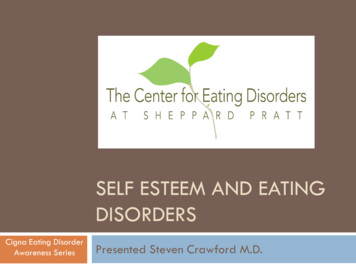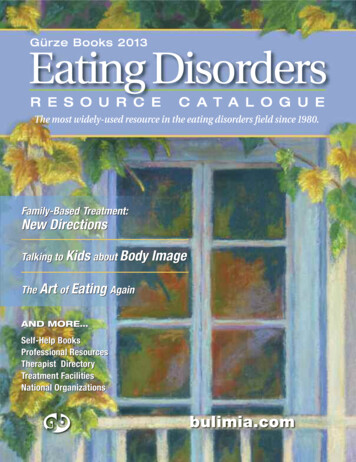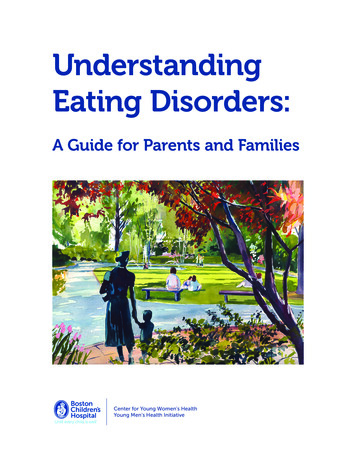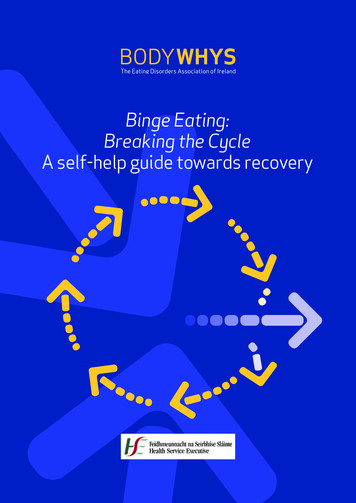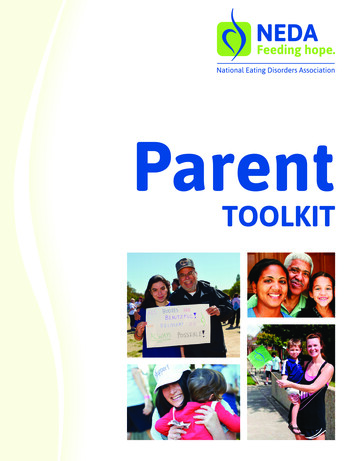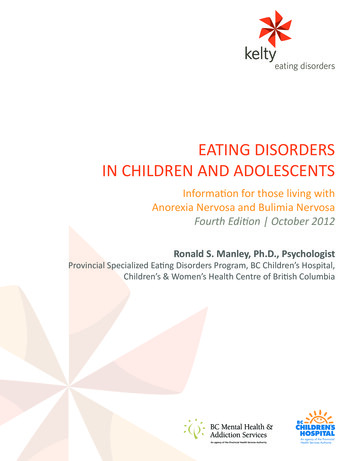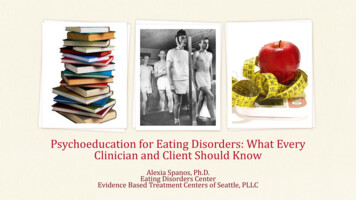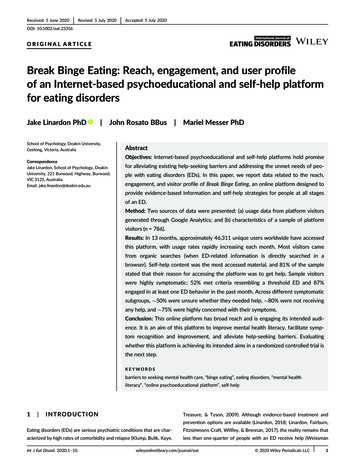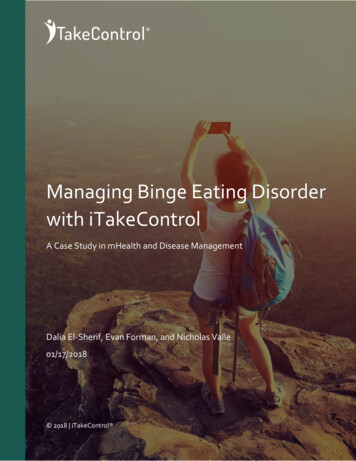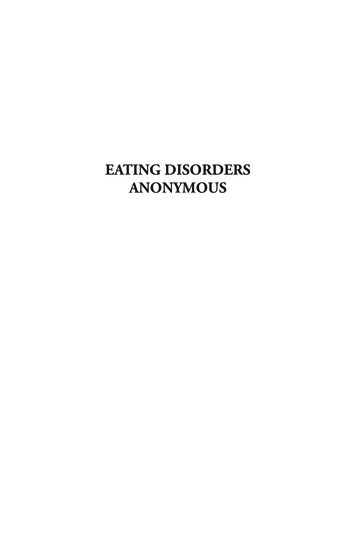
Transcription
EATING DISORDERSANONYMOUS
EATING DISORDERSANONYMOUSThe Story ofHow We Recovered fromOur Eating DisordersThe General Service Board ofEating Disorders Anonymous2016
Eating Disorders AnonymousThe Story of How We Recovered from Our Eating Disorders 2016, 2021 by the General Service Board ofEating Disorders Anonymous, Inc.All rights reserved.EDA’s program of recovery is adapted from the first 164 pages of AlcoholicsAnonymous, the “Big Book,” with permission from Alcoholics AnonymousWorld Services, Inc. Permission to reprint and adapt this material does notmean that AA has reviewed or approved this or any other EDA material. AAis a program for recovery from alcoholism only. Use of AA material in the program of EDA, which is patterned after that of AA but which addresses otherissues, does not constitute endorsement by or affiliation with AA.Published by Gürze Books, Carlsbad, CA (gurzebooks.com)as a service to:Eating Disorders .orgLibrary of Congress Cataloging-in-Publication DataNames: General Service Board. Eating Disorders Anonymous.Title: Eating disorders anonymous : the story of how we recovered fromour eating disorders / the General Service Board of Eating DisordersAnonymous.Description: Carlsbad, CA : Gürze Books, [2016] Includes bibliographicalreferences.Identifiers: LCCN 2016038763 ISBN 9780936077857 (trade pbk.) ISBN9780936077864 (ebook)Subjects: LCSH: Eating disorders--Treatment.Classification: LCC RC552.E18 DDC 616.85/26--dc23LC record available at https://lccn.loc.gov/2016038763Printed in the United States of America.5 7 9 0 8 6
CONTENTSPrefacexiDoctors’ OpinionsxixLetters of Supportxxxi1 Gisele’s Story of Hope512 There Is a Solution693 More About Eating Disorders844 We Agnostics, Atheists, and Believers995 How It Works (Steps 1 – 4)1106 Into Action (Steps 5 – 11)1597 Working with Others (Step 12)199Personal StoriesPart IPioneers of EDA1 Free At Last243When this third member of EDA recognized that full recoverywould remain out of reach until she rebuilt self-trust, sheconsciously accepted responsibility for addressing her own basicneeds and began taking small risks to express emotions safely. Astrust grew, so did love, joy, peace, and freedom.2 A Life Solution262Accepting powerlessness over her eating disorder and responsibilityfor her actions helped her find an answer that works in all aspectsof life.3 A Program For People Who Work It271Going to any length for recovery is just the beginning of her story.4 One Day at a TimeTrue honesty has her showing up for life—one day at a time.278
viEATING DISORDERS ANONYMOUS5 One Step at a Time282By taking and working one Step at a time, she found a powergreater than herself and said goodbye to her eating disorder.6 Overcoming Unmanageability293Taking responsibility for her commitment to balance andrecovery led her to work through the layers and find a life ofrichness and joy.7 Recovery is a Journey303Letting go of the need to be in control, she stopped judging herselfand discovered self-acceptance, honesty, and the power of service.Part IIThey Stopped in Time1 As Sick as My Secrets313She showed up, did the work and, most importantly, told thetruth. In return she was met with compassion, encouragement, andsupport that shaped her recovery.2 A Treatment Professional Shares Her Story322When she began to communicate out loud, her eating disorderquieted; she became comfortable with being perfectly imperfect.Happy and free in recovery, she shares that surrender meant“joining the winning team.”3 Authenticity Freed Me to Find My Purpose329Just as her connection to a Higher Power inspires her to pursuerecovery every day, she inspires others to find their true worth.4 Faith in the Fellowship333In her first meeting, she was amazed at the beautiful kindnessand openness of the people who recovered; then, through workingthe Steps, she became one of them.5 Freedom Beyond MeasureWhen her obsession with numbers lifted and she became mindfulof her inherent worth, she was inspired to help others and becamea clinical psychologist.336
CONTENTS6 Freedom Through Working the Stepsvii346The Steps transformed her life, and now she feels beauty not assomething to be found in a mirror, but from the light she sees inand shares with others.7 A Life Worth Living350Once her eating disorder had taken its toll, this accomplishedveteran’s unhappiness finally drove her to find a solution. Today, shefinds joy through living authentically—comfortable in her own skin.8 He Used to Work for His ED; Now He Works for Joy357His biggest blessing was being ready to change. He worked theSteps and learned self-compassion and understanding.9 I Am Joie de Vivre363When she chose EDA, she found a source of strength that broughtthe light back to her eyes.10 In God’s Hands368As a result of surrendering to the program, she became thewoman that she believes God intended her to be, gaining peace,freedom, and an ability to connect with others.11 Life Sentence Lifted378She earned her freedom when she stopped trying to be perfect andaccepted life on life’s terms.12 Recovery After Forty-Two Years of Bulimia380Willingness, commitment, and perseverance transformed a tennispro’s resignation—that she would always have an eating disorder—into a durable recovery.13 Recovery Opened a Whole New World388When she began to trust people, she discovered her voiceand experienced the joy of sharing with others on a deep andmeaningful level.14 Welcoming Life with Open ArmsShe graduated college with high honors and helped with multiplesocial justice campaigns, yet it wasn’t until she let go of rigidity thatshe found her own kind and compassionate heart. Surrender—humility—turned out to be the gateway to freedom.396
viiiEATING DISORDERS ANONYMOUS15 What Doesn’t Kill You 401Through perseverance and research, she discovered a residentialprogram where she learned priceless lessons. She is now aware of herworth and mindful of her many blessings.Part IIIThey Lost Nearly All1 A Man Finds Hope and Meaning in Recovery from Anorexia407He once believed his purpose in life was to have an eatingdisorder; now, his purpose is to recover so he can reach out andhelp others.2 Break the Rules and Enjoy the Promises414Living with an eating disorder is not truly living. Moving fromself-loathing to self-love, she is at peace through her sustainingrelationship with her Higher Power.3 Dancing From Darkness to Daylight418Recovery is about honesty and willingness to grow—andexperiencing that growth. Her life today wouldn’t be possible if shehadn’t stepped onto the road of recovery.4 Dual Diagnosis422By learning to be comfortable with change, she allows herself tobe guided by her Higher Power and the principles of EDA. And lifeis just amazing!5 Following the Light of Recovery434After twenty-six years with an eating disorder, she wanted to leada normal life. Recovery was about faith, hope, and a willingness toaccept and love herself—inside and out.6 Making the Most of Every MomentHer dedication to therapy, determination to stop bingeing,and EDA support have given her a life of love today. No longerdependent on an eating disorder, she shares her “Steps to HappinessI Now Know.”445
CONTENTS7 Off to the Racesix449She thought the mirror, scale, and measuring tape were her HolyGrail to becoming happy, joyous, and free. But when she got toEDA, she learned that she had it all wrong—and started living inthe solution.8 Owning My Story458Instead of letting an eating disorder speak for her, she now usesher voice to carry the message of recovery.9 Recover or Die: Sick of Suffering467Now a sponsor, she accepted that perfection doesn’t equalhappiness and she regained her purpose and spirit through EDA.10 Wicked, Hot Mess to Alive and Free472She was in a halfway house when she finally found the helpshe needed to put her life back together. Her love for God nowallows her to make use of her experiences to help others in similarcircumstances.AppendicesAppendix A: The Twelve Steps and Twelve Traditions of EDA 482Appendix B: A Perspective on Balance490Appendix C: An EDA Member Works the Steps500Appendix D: Example 4th Step Inventory525Appendix E: Contacting EDA544
PREFACEWe, the members of Eating Disorders Anonymous(EDA), acknowledge our huge debt to the founders and Fellowship of Alcoholics Anonymous (AA). EDAhas deep roots in the Twelve-Step program of AA and theTwelve Traditions of the AA Fellowship.1 Although recovery from an eating disorder is not identical to recovery fromalcoholism, we wish to convey that we have only adaptedthe AA program as necessary, ensuring those with eatingdisorders can readily grasp and apply the AA founders’concepts.In truth, some of these adaptations have been significant. The founders of EDA recognized an “abstinence first”approach to recovery from eating disorders to be ineffective. Thus, EDA’s focus on balance and perspective, ratherthan abstinence, distinguishes it from most other TwelveStep fellowships. EDA fully embraces the Twelve-Step concept that “recovery is a process not an event.” When recovery entails dealing with food, something we need almost asmuch as air and water, any rigid approach to food-relatedbehaviors—including thinking of food as “an addiction”—simply did not work for us. We think our approach is effective because it focuses our attention on changes that lead tolong-term success.EDA’s program of recovery is adapted from the first 164 pages of AlcoholicsAnonymous, the “Big Book,” with permission from Alcoholics AnonymousWorld Services, Inc. Permission to reprint and adapt this material does notmean that AA has reviewed or approved this or any other EDA material. AAis a program for recovery from alcoholism only. Use of AA material in the program of EDA, which is patterned after that of AA but which addresses otherissues, does not constitute endorsement by or affiliation with AA.1xi
xiiEATING DISORDERS ANONYMOUSWhile this volume is not intended to be a supplement to Alcoholics Anonymous, we highly recommend thatthe reader become familiar with the original text.2 Muchguidance and inspiration can be found there. Note that thechapters in both books are arranged similarly to accommodate easy cross-reference.The solution we outline here is based on our personalexperiences of having and recovering from our eating disorders. For members of EDA, this typically means gainingperspective (Step One), gaining hope (Step Two), preparingto make changes (Steps Three and Four), becoming accountable (Step Five), surrendering to a new approach without fearof self-recrimination or judgment (Steps Six and Seven), recognizing and repairing damage done (Steps Eight and Nine),maintaining integrity and trust (Step Ten), and building afoundation for, and then expanding on, a purpose-driven life(Step Eleven). As a result of working these Steps, we experience a transformation that enables us to gain—and maintain—a healthy perspective. This enables us to break free,and stay free, from eating-disordered thoughts and behaviors. Most EDA members recognize this transformation as aspiritual awakening,3 yet the transcendent experience of fullrecovery is not limited to those of us who adopt a spiritualor religious faith. In Step Twelve, we share our experience,Early members of EDA successfully used the AA “Big Book” and the AA“Twelve and Twelve,” translating the words “alcohol” and “drinking” to “acting out” and the word “alcoholic” to “eating disordered.” Sponsors may, ofcourse, still do so. An online, English version of the 4th edition of the AA “BigBook,” Alcoholics Anonymous, is available here: http://www.aa.org/pages/en US/alcoholics-anonymous, and an online, English version of the AA text, TwelveSteps and Twelve Traditions, is available here: http://www.aa.org/pages/en US/twelve-steps-and-twelve-traditions.3The term “spiritual awakening” can refer to an event—a vital spiritual experience—or to a gradual change. Those of us who are atheists also experiencea transformation, enabling us to place service before selfishness.2
PREFACExiiistrength, and hope. We apply the principles of the programto all we do: this way of looking at life and our place in itworks under all conditions.EDA has no opinion on the current scientific, medical, and humanistic debate about whether an eating disorder is an addiction or whether an addiction is a disease. Wewant no one to be distracted by academic arguments aboutlabels. The founders of AA made a serious effort to clarifythe complexity of the various manifestations and forms ofalcoholism: theirs was not a “one-size-fits-all” definition,and neither is ours. Our stories show a great diversity intype and severity. Some of our members conceive of theireating disorders as an addiction and a disease, while othersdo not. In the end, we find it matters very little what labelswe apply, if any at all; our solution is not contingent uponany specific conception of what an eating disorder may ormay not be.Some medical professionals have been critical ofTwelve-Step groups for denigrating the value of medicaltreatment. They are concerned that viewing an eating disorder as an addiction or disease absolves the individual ofresponsibility for addressing their condition, prevents themfrom recognizing that their condition is treatable, createsa culture in which patients believe they are unable to fullyrecover, and requires a cult-like dependence on a spiritualpower as a marker of recovery.We certainly hope that anyone with a genuine understanding of the Twelve-Step programs of AA and EDA willimmediately recognize the flaws in these objections. Forthose who are less familiar with these programs, we addressthese points one by one.
xivEATING DISORDERS ANONYMOUSFirst, EDA members typically work closely with medical professionals. EDA recognizes that many people need,and greatly benefit from, the support of the medical community. Most EDA members are eager to help newcomersfind and leverage whatever support is available.Next, in all Twelve-Step programs, the individual isultimately held accountable for their behavior. Rather thanusing “the condition” as an excuse for failing to exerciseone’s own agency to recover, all Twelve-Step programs require members to recognize that they alone must make thedecision to change; they alone must take action for the decision to be effective. Those who object to the Twelve-Stepapproach on the basis that it is a “culture of powerlessness”should recognize that the first step is but an admission ofperspective gained; the rest of the steps are all about gainingthe power needed to build and sustain recovery.Those who object to Twelve-Step programs on the basis that they foster dependence on a spiritual entity shouldunderstand that for most EDA members, spiritual dependence produces independence from fear, self-pity, despair,myriad forms of obsession, and freedom from mortal peril.For others, working the Twelve Steps need not entail reliance on any spiritual source at all. The choice of how towork the Steps is up to the individual. “God” in EDA literature can mean the Deity, a deity, a spiritual entity ofone’s own understanding (a Higher Power), or a non-spiritual conception (a higher purpose). Reliance on any one ofthese conceptions confers a perspective that transcends ourimmediate physical, social, and emotional circumstancesand allows us to “keep calm and carry on” with what really matters. All Twelve-Step groups encourage members to“take what you can use and leave the rest.” This is not astatement to be found in any cult.
PREFACExvFinally, while AA maintains a position that can be described as “once an alcoholic, always an alcoholic,” EDA’sstance is that people can and often do recover fully fromtheir eating disorders. In EDA, we recognize that our responses to life are conditioned by how we have reacted inthe past. And while life-long patterns can be changed, it ishard work. EDA provides support for those who are readyto engage in the work of recovery.In early recovery, we learn to take small risks to buildtrust with ourselves and others. We soon discover that thistakes time and patience, so we do our best to follow theguidance we hear in EDA meetings: Eat when hungry, stop when moderately full.Consistent nutrition is essential for recovery. Recovery is about feelings, not food, but we can’treason or build trust when bingeing, purging, orstarving. Get basic needs met first. If hungry, eat. If angry,find a safe outlet. If lonely, reach out. If tired,sleep. If ashamed, talk about it. Ask others for input, then make your own decisions. When anxious or troubled, do something thatfocuses attention on your physical senses, getoutside, pray, or meditate. Then deal with theproblem head-on. Get open with others. Honesty restores integrity. Develop willingness to look at things differently.Recovery is not rigid.
xviEATING DISORDERS ANONYMOUS Go to Twelve-Step meetings, read the literature,and work the Steps with a sponsor. Be proactive and plan your recovery.Following such suggestions, and relying on others’experience, strength and hope, we may do well for days,weeks, or months—only to find ourselves right back intired, old habits that don’t serve us or anyone else. Indeed,a “normal” recovery often involves what can seem like a distressingly long period of back-and-forth, as we learn moreabout what changes are truly required. But mistakes thatlead us back to old behaviors should not be feared: theycan be powerful tools for building a solid foundation if weare consistently open and honest about our expectations,resentments, fears, self-pity, shame, guilt, confusion, frustration, and despair—all the messy emotions that drove usinto our eating disorders in the first place. This then opensus up to the difficult process of changing the thoughts thatunderlie these emotions. To maintain progress, we need asmuch support as we can get.We in EDA don’t find it helpful to count numbers ofany sort: we don’t weigh or measure anything, includingdays or years of freedom. Instead, we recognize what we call“milestones of recovery,” which are self-defined markers onour journey. Even on our worst days, it is essential to recognize that we are doing things that are right and good, andsupportive of our success. In meetings, we encourage everyone to claim as many milestones as they can. As we resolveour underlying thinking problems and become more positive and proactive, our recovery grows stronger and moreflexible. By practicing the habits of thought and behaviorwe learn through working the Twelve Steps, we find we can
PREFACExviirely on them to bring us durable peace and freedom: weneed never return to our old patterns.We still have normal life challenges, of course, and weexperience emotions just as deeply as before—though thereare differences. In full recovery, many of our most powerfulemotions are positive: love, joy, delight, satisfaction, and asense of wholeness and happiness. When we experience distressing emotions, we no longer seek escape; we know whatto do and generally do it automatically. When troubled,we take stock, seek to understand where our thinking hasgone awry, make amends where needed, and immediatelyturn our attention to how we can use our experience toserve some good purpose. Full recovery is resilient. We areable to do all sorts of things that used to “trigger” obsessive thinking and eating-disordered behavior. We can goanywhere and do anything that normal people do, withoutre-engaging our eating disorders: we are restored to sanity.Our EDA groups include members who are religious,spiritual, agnostic, and atheist. Though our ideas aboutGod, Higher Power, and higher purpose may be very different, this creates no great friction among us. We are alliedin our common struggle to establish reliance on somethinggreater than ourselves. Rather than debating theologicaldifferences, we grow in tolerance and humility as we shareour experience, strength, and hope with each other. Wecherish the diversity of our ideas and our stories, for theseoffer fresh hope to the newcomer.We respect each individual’s journey. We encouragemembers who have a strong faith in God to continue toseek God with all their hearts. We support members whoseek to grow along different spiritual lines, and we respectmembers who seek peace in service to the greater good. InEDA, we celebrate everyone in recovery.
xviiiEATING DISORDERS ANONYMOUSWe acknowledge that EDA has no monopoly on recovery. Many people recover from an eating disorder without any intervention, while others benefit from medical,social, and psychological support. We appreciate and respect that a combination of support is often desperatelyneeded by those who find themselves as profoundly helpless in their eating disorders as we once were.We know our solution—the program of EDA—relieved us of our eating disorders. Our main purpose inwriting this text is to share our accumulated experience,strength, and hope so that others might also find relief. Wehope that you, the reader, will find guidance you can use inthe following pages. And we wish that everyone might behappy, joyous, and free.
DOCTORS’ OPINIONSEDA members encourage everyone seeking recovery froman eating disorder to work with qualified medical professionals. For the most severely afflicted, a trained and experienced team—usually including a physician, a psychiatrist, a psychologist, and a registered dietician—can meanthe difference between life and death. Even in relativelymild cases, caring and trained professionals can be essentialto sustained change.We think everyone engaged in eating disorders recovery will be interested in what medical professionals themselves have to say about the process and about our organization. It is a great honor to offer the following letters ofsupport from three such individuals who have dedicatedtheir time, talent, and energy to helping people with eatingdisorders develop strong foundations for recovery.Our first letter is from Dr. Ray Lemberg, PhD. Dr.Lemberg is a clinical psychologist in practice in Arizonasince 1977. He received his doctorate from the Universityof Maryland and is a pioneer in the field of eating disorders,having formed the first psychiatric inpatient program inArizona in 1980. Dr. Lemberg has made over one hundredpresentations on this subject; is Associate Editor of: EatingDisorders, The Journal of Treatment and Prevention; is theauthor of forty-five papers and publications; and editor ofthree books on eating disorders, the most recent, co-editedwith Leigh Cohn: Current Findings on Males with EatingDisorders (NY/London, Routledge Press, 2014).xix
xxEATING DISORDERS ANONYMOUSDr. Ray Lemberg’s OpinionTo Whom It May Concern:When the “Big Book” of Alcoholics Anonymous waspublished in 1939 no one could have dreamed of itsmonumental impact. AA is now over 2,000,000 membersstrong. Eating Disorders Anonymous (EDA), which wasfounded in 2000 in Phoenix, Arizona, is modeled on thesame Twelve-Step philosophy, respecting and preservingthe major tenets of AA. The Twelve-Step model has beenpowerful in promoting recovery through support and fellowship as well as by demonstrating the success of thosewho were able to escape the grip of obsessive thought andcompulsive behavior.Years ago, Dr. Scott Peck, psychiatrist, wrote the bestselling book, The Road Less Traveled, which had a significant impact at that time. Dr. Peck conveyed that the pursuit of happiness was misguided, as happiness is a fleetingemotion. Instead, fulfillment in life is achieved, in part,by delaying gratification and overcoming obstacles that inhibit growth and transformation.The EDA philosophy has many parallels to these teachings. A major contribution by EDA is an aim to broadenthe understanding and conceptualization of a “HigherPower.” In essence, finding meaning in life is often dependent on finding purpose outside and beyond self-preservation and self-interest.Typically, the process of recovery is arduous and characterized by backward and forward movement that ultimately is necessary for creating a fundamental life change. Itinvolves internalizing the belief that each person’s journeyis uniquely individual, and that personal transformation ispossible. It also involves the sense of belonging to a fellowship that empowers a person with the strength of knowingthat he/she is not going it alone.
DOCTORS’ OPINIONSxxiWithin the EDA text that follows, it is proposed thatthe concept of a Higher Power can be embodied by theidea of a higher purpose. This allows those who do notembrace religious convictions to empower themselves witha higher level of life’s meaning, and enables them to evolveinto more complete and resilient people. Recovery is muchless about one’s relationship with food and much moreabout one’s relationship with oneself, others, and a higherpurpose.In this context, for some people the concept of faith isin a Higher Power, for others it is in a higher purpose. Bothembrace a deep commitment and reliance on believing thatsomeone or something is of much greater importance thanself.The work that follows is innovative, significant, andgroundbreaking.Raymond Lemberg, PhDClinical PsychologistOur second letter is from psychologist Dr. SumerAeed, whose guidance was critical in EDA’s identificationof balance and perspective as goals of recovery. Dr. Aeedholds a doctoral degree in Educational Psychology/Counseling Emphasis, a master’s degree in Counseling Psychology, and a BA in International Relations. She has workedfor over twenty years in the counseling, consultation, andeducation fields helping individuals and families createhealthier relationships. As the founder of What’s Your StoryExperiences—experiential workshops that support transformation and healing—Dr. Aeed guides individuals to explore the power of their unique stories. An adjunct facultymember at Northern Arizona University, she has developedprevention programs for youth, serves on several boardswith a focus on healing and prevention work, and writes
xxiiEATING DISORDERS ANONYMOUSarticles in the field of mental health for numerous magazines and websites. Dr. Aeed’s work helped EDA embracethe idea that consciously taking care of our own basic needsis essential to establishing relationships of trust. This ideais central to EDA’s message of recovery, and we are gratefulfor her contribution.Dr. Sumer Aeed’s OpinionTo Whom It May Concern:Our identity is forged by our story; that story determines our emotions, behaviors, relationships, possibilities,and truth. People conquer their eating disorders in manydifferent ways. Yet we often seek “the” answer, or “the”story, rather than looking for our own. Thankfully, thereis a way out.As a psychologist and educator with twenty years ofexperience working with eating concerns across the spectrum, I am passionate about individuals having access to abroad base of tools and solutions on their road to recovery.I have not only witnessed the devastation that eating disorders can play out in people’s lives, I have seen the stories ofhope and new beginnings that can be forged from the pain.Research shows us that eating disorders stem from biopsycho-social-spiritual roots, and my experience is thata resilient recovery allows for tools in all of those areas.Through the power of the group, the power of shared stories, and the power of others speaking into our lives, wecan co-author our recovery stories, borrowing pieces fromeach other’s chapters and weaving them into our own.What I often see in my clients are patterns in which theygo 100 mph, get inspired, dig in and fall back down, seethe breakthrough, and then end in yet another breakdown.They decide it’s all a waste of time and then think, I can’t
DOCTORS’ OPINIONSkeep living like this. They are determined to find “the” answer and get it exactly right, while ensuring they don’t riskor let go of anything. They are stuck in not being willingto change the questions they ask, which are still all aboutbody, food, and control. This is all that they know and allthat they trust, even though it is gradually killing them dayby day. They watch others recover and feel hopeless, sometimes wondering if people “in recovery” are all just lying.Then they see hope in their eyes and peace as they sit sideby side, realizing they aren’t lying, and wanting what theyhave. Clients then become willing to listen—even when itdoes not make sense and challenges all that they are doing—desperate to find some other way to live and wearyof the despair, disgust, and shame weighing them down.Although my experience stems from the varied storiesthat people struggling with eating challenges bring to their“table,” aspects of the following might sound familiar tomany readers. The more things spin out of control inside,the harder you work to keep the outside looking “fine”—not realizing there is any other way to live, certain everyonefeels this way, while at the same time afraid you are aloneand broken in some unspeakable, unfixable way. Otherssee possibilities that you are not yet ready to claim; you letgo of old ways of thinking and create new habits; you getto the “end” and then start all over again. You hide, youare seen, and you feel certain you would be the one personthat the tools would not work for. You have slow chaptersof great effort with seemingly little benefit—journaling,meditating, yelling at the fridge, not wanting to look inthe mirror. You face the devastation of the eating disorder,still not able to tell the truth. You live with your body cutoff from the head down, refusing to connect in any way tothis horrible thing you are stuck in, with which you must“do life.” You push your body past any logical or healthylimits, seeing what you are doing, and still not being ablexxiii
xxivEATING DISORDERS ANONYMOUSto stop. You feel like someone else’s foot is on the accelerator, racing y
1 EDA’s program of recovery is adapted from the first 164 pages of Alcoholics Anonymous, the “Big Book,” with permission from Alcoholics Anonymous World Services, Inc. Permission to reprint and adapt this material does not mean that AA has reviewed or approved this or any other EDA material. AA
